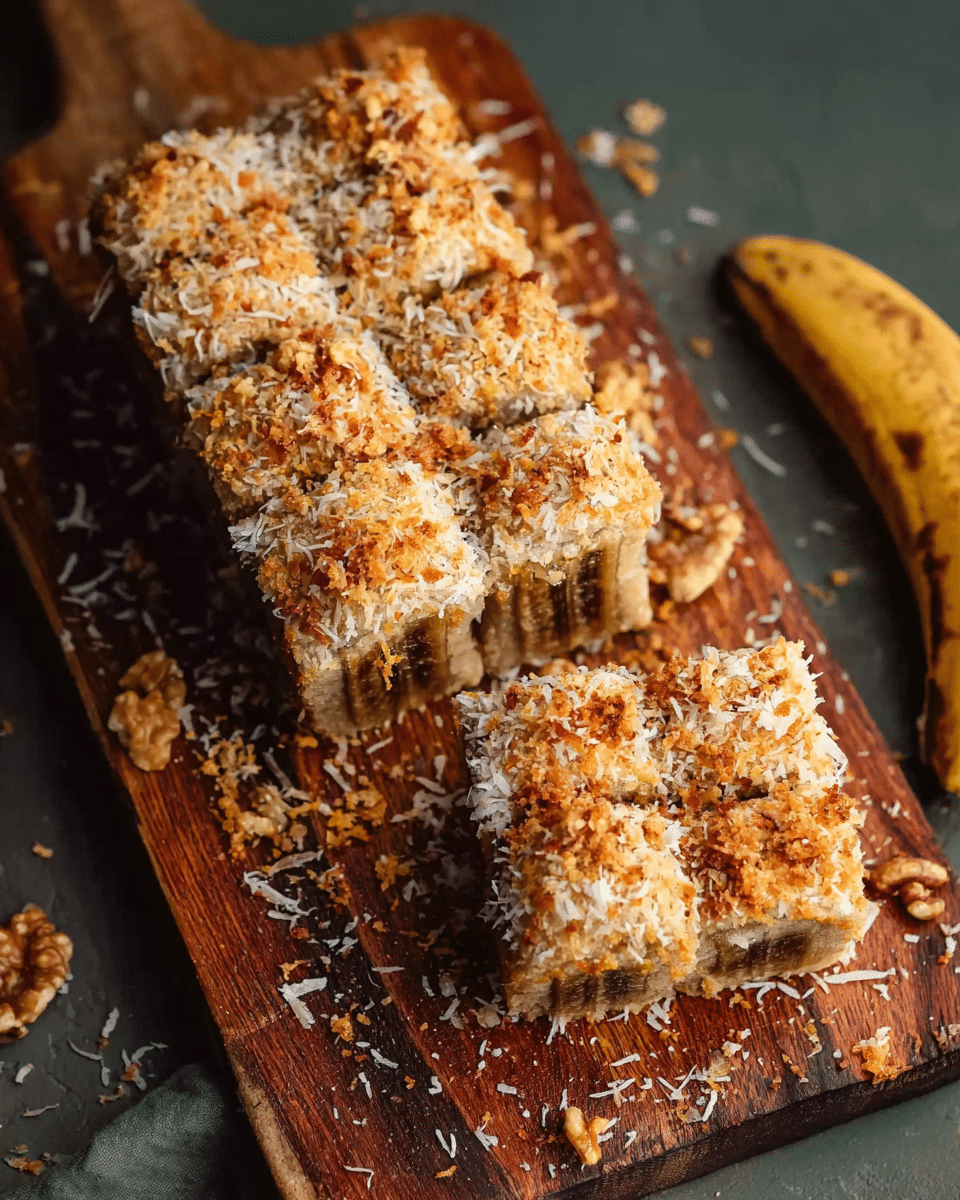This Banana Mochi Bread is a delicious fusion of textures and flavors, blending the rich sweetness of ripe bananas with the chewy mochi-like consistency of glutinous rice flour. Topped with crunchy walnuts and fragrant toasted coconut, it makes for a satisfying snack or a sweet treat. It’s perfect for anyone looking for a unique and gluten-free dessert or breakfast option.
Full Recipe:
Ingredients
-
2 ripe bananas, mashed
-
2 cups glutinous rice flour
-
1/2 cup sugar
-
1 tsp baking powder
-
1/4 tsp salt
-
1 cup coconut milk (or any milk of your choice)
-
1/4 cup avocado oil
-
1 tsp vanilla extract
-
1/2 cup chopped walnuts
-
1/2 cup toasted coconut flakes
Directions
-
Preheat your oven to 350°F (175°C). Grease a 9×9 inch baking dish or line it with parchment paper.
-
In a large bowl, combine the glutinous rice flour, sugar, baking powder, and salt. Mix well.
-
In another bowl, mix the mashed bananas, coconut milk, avocado oil, and vanilla extract until smooth.
-
Pour the wet ingredients into the dry ingredients and mix until well combined. The batter will be thick and sticky.
-
Fold in the chopped walnuts.
-
Pour the batter into the prepared baking dish and spread it out evenly. Bake for 40-45 minutes, or until a toothpick inserted into the center comes out clean.
-
While the mochi bread is baking, toast the coconut flakes in a dry skillet over medium heat until golden brown.
-
Once the bread has cooled completely, sprinkle the toasted coconut flakes on top.
-
Cut the mochi bread into squares and serve.
Nutrients (per serving)
-
Calories: 365 kcal
-
Carbohydrates: 50g
-
Protein: 4g
-
Fat: 18g
-
Saturated Fat: 7g
-
Polyunsaturated Fat: 4g
-
Monounsaturated Fat: 5g
-
Sodium: 129mg
-
Potassium: 223mg
-
Fiber: 2g
-
Sugar: 16g
-
Vitamin A: 18 IU
-
Vitamin C: 3mg
-
Calcium: 43mg
-
Iron: 1mg
The Unique Texture of Mochi Bread
One of the most appealing aspects of Banana Mochi Bread is its texture. While traditional banana bread tends to be light and fluffy, this mochi version offers a delightful chewiness that sets it apart. This distinctive texture comes from the use of glutinous rice flour, which is a key ingredient in mochi, the famous Japanese dessert. When baked, glutinous rice flour gives the bread a dense, chewy consistency that’s more substantial than typical quick breads.
The chewy texture of the mochi bread makes it incredibly satisfying to eat. Unlike the crumbly texture of traditional cakes or breads, the mochi bread provides a firm bite and a rich mouthfeel. The combination of the chewy consistency and the natural sweetness of bananas makes for a delightful contrast that is both comforting and indulgent. The crunchy topping of walnuts and toasted coconut adds even more texture, creating a perfect balance of chewiness and crunch in every bite.
The Sweetness of Ripe Bananas
Ripe bananas are a star ingredient in Banana Mochi Bread, providing not only natural sweetness but also moisture. The sweetness of the bananas enhances the flavor of the bread, making it a satisfying treat without the need for added refined sugars. As bananas ripen, their natural sugars develop, giving them a deeper, more intense sweetness that perfectly complements the other ingredients in the bread.
In addition to their sweetness, bananas also help keep the bread moist. The high moisture content of bananas makes them an ideal ingredient in baked goods, as they prevent the bread from drying out and ensure it remains soft and tender. The addition of bananas in this recipe is what gives the bread its irresistibly moist texture, making each slice as soft and pillowy as the last.
The Role of Glutinous Rice Flour
Glutinous rice flour is the key to achieving the chewy, mochi-like texture in this bread. Unlike regular rice flour, glutinous rice flour is made from a special type of rice that is sticky and has a higher starch content. When mixed with liquids and baked, it forms a dense, chewy consistency that gives the bread its signature texture. The use of glutinous rice flour also makes this recipe gluten-free, making it a great option for those who have dietary restrictions.
The unique properties of glutinous rice flour provide the bread with a satisfying texture that is unlike any other. It helps create a dense and chewy interior while still allowing the bread to hold its shape when sliced. This gives Banana Mochi Bread a delightful heft and substance that is both comforting and indulgent.
Adding Crunch with Walnuts and Toasted Coconut
The addition of chopped walnuts and toasted coconut flakes gives the Banana Mochi Bread a delightful contrast in both flavor and texture. Walnuts provide a crunchy, slightly earthy flavor that complements the sweetness of the bananas and the richness of the coconut milk. Their natural oils also add a subtle richness to the bread, making each bite more satisfying.
Toasted coconut flakes, on the other hand, add a sweet, nutty crunch that enhances the overall flavor profile. As the coconut is toasted, it develops a deeper, caramelized flavor that pairs beautifully with the other ingredients. The toasted coconut not only adds texture but also a hint of tropical flavor, making the bread feel more indulgent and festive.
These two toppings—walnuts and toasted coconut—create a perfect contrast to the chewy, mochi-like bread. The added crunch provides a satisfying bite, while the warm, nutty flavors of the walnuts and coconut elevate the bread to something truly special.
The Versatility of Banana Mochi Bread
One of the best things about Banana Mochi Bread is its versatility. While it makes a great snack or dessert on its own, it can also be paired with other items for a more substantial breakfast or brunch. The bread’s naturally sweet and moist texture makes it a great accompaniment to a hot cup of coffee or tea. The chewiness of the bread holds up well with spreads, so feel free to top it with peanut butter, almond butter, or even a dollop of whipped cream for a more decadent treat.
Banana Mochi Bread can also be served at gatherings or parties, where it can be sliced into small squares and shared with friends and family. Its unique texture and flavor profile make it a conversation starter, and its gluten-free nature ensures that it can be enjoyed by a wide variety of people, including those with gluten sensitivities or dietary restrictions.
Making It Your Own: Customizing the Recipe
One of the wonderful aspects of Banana Mochi Bread is how customizable it is. While the recipe as written is delicious, you can easily tweak it to suit your personal preferences or dietary needs. For example, if you’re looking for a sweeter version of the bread, you can increase the amount of sugar or add honey or maple syrup to the batter.
You can also experiment with different nuts or seeds in place of the walnuts. Pecans, almonds, or even pumpkin seeds would make excellent substitutes, adding their own unique flavors and textures to the bread. Similarly, if you’re not a fan of coconut, you can skip the toasted coconut flakes and replace them with dried fruit like raisins or cranberries for added sweetness and chewiness.
For those looking to make this recipe vegan, you can easily substitute the dairy and eggs. Coconut milk can be replaced with almond or soy milk, and a flax egg or chia egg can be used instead of the regular eggs. With a few simple substitutions, you can make this recipe fit a variety of dietary preferences without compromising on flavor or texture.
Serving and Storing Banana Mochi Bread
Banana Mochi Bread is best enjoyed fresh, but it also stores well for later enjoyment. To store, simply place the bread in an airtight container at room temperature for up to three days. If you prefer a firmer texture, you can refrigerate the bread, though the moisture content will decrease slightly. For longer storage, Banana Mochi Bread can be frozen for up to a month. Just slice the bread into portions and wrap them tightly in plastic wrap before freezing. When you’re ready to enjoy it again, simply thaw the slices at room temperature or warm them up in the microwave.
If you’re serving the bread for a special occasion, it can be garnished with additional toppings like whipped cream, fresh fruit, or a drizzle of chocolate sauce. This gives it an extra indulgent touch, turning a simple bread into an elegant dessert or snack.
Why You Should Try Banana Mochi Bread
Banana Mochi Bread is a unique, gluten-free dessert that combines the best of both worlds: the rich flavor of ripe bananas and the chewy texture of mochi. It’s a fun, indulgent treat that’s perfect for anyone looking to try something new or explore different textures in their baking. The combination of bananas, glutinous rice flour, walnuts, and toasted coconut makes for a dessert that’s both comforting and satisfying, while still feeling light and refreshing. It’s a recipe that’s as versatile as it is delicious, making it a great addition to any meal or occasion.
Whether you’re a fan of gluten-free baking, looking for a new way to enjoy bananas, or simply craving a unique dessert, Banana Mochi Bread is sure to impress. The texture is unlike any other, the flavors are perfectly balanced, and the end result is a dessert that is as beautiful as it is tasty. With a few simple ingredients, you can create a delightful treat that will leave everyone asking for the recipe.
Conclusion
In conclusion, Banana Mochi Bread is a delightful fusion of textures and flavors that combines the richness of bananas with the chewy consistency of glutinous rice flour. Topped with crunchy walnuts and toasted coconut, this gluten-free treat offers a satisfying bite that’s both indulgent and refreshing. Its versatility makes it perfect for a variety of occasions, from a sweet breakfast to a memorable dessert. With its unique texture and flavor, Banana Mochi Bread is sure to become a beloved addition to your recipe collection.






